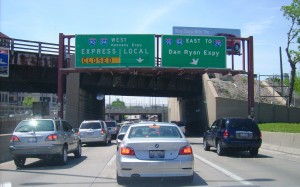Traffic congestion continues to grow on Kennedy, Edens
Chronicle Media — November 4, 2015
Poor mid-20th century road design — three lanes each of expressway each merging into four inbound lanes (minus the reversibles) south of the Edens-Kennedy junction set the stage for the almost-daily commuting nightmare.
Traffic-battered inbound motorists on the Kennedy and Edens expressways have to carefully plan their afternoon commutes to avoid being stuck in jams that stretch as much as 25 miles from O’Hare Airport or Lake-Cook Road all the way downtown.
Tens of thousands of commuters on both crammed highways now have to navigate a reverse-commute — outbound in the morning and especially inbound in the afternoon — that is usually worse than the traditional journey to and from downtown.
The Illinois Department of Transportation has made adjustments in recent years in employing the two reversible lanes on the Kennedy through the Ohio Street off-ramp to open the flow for the new traffic reality. But most days it has still proven inadequate to significantly ease the jams that seem the equal of Los Angeles freeway mega-clots.
Although WBBM-Radio traffic reporter Bart Shore, covering the beat since 2000, acknowledges the adjustments in the reversible lanes has helped somewhat, “I think they (IDOT) need to really look at that a little bit more than they’ve had.”
Poor mid-20th century road design — three lanes each of expressway each merging into four inbound lanes (minus the reversibles) south of the Edens-Kennedy junction set the stage for the almost-daily commuting nightmare. The inability of the late Chicago Mayor Richard J. Daley to build the Crosstown Expressway, starting at that junction, as a downtown bypass made matters worse.
The die was cast when many businesses moved from the city to the northern, northwest and west suburbs with scarce public-transportation access to cut traffic from reverse-commuters.
The reverse-commute problems seemed to bubble up around 1990 with some of Chicago’s best-known celebrities drawing attention to the issue. Long inbound backups on the Edens going into the Kennedy made several Bulls players, coming from the Northbrook area, late for a 6 p.m. reporting time to games at old Chicago Stadium and the United Center. Former Bulls center Bill Wennington, now the team’s radio color analyst, said he sometimes drove on the shoulder to get around the worst jams.
A shoulder-driver was observed on the inbound Edens near Foster during a relatively moderate 4 p.m. jam last week. To ease such frustrations, IDOT has lengthened the times it keeps the reversibles open inbound.
For several years, as Friday traffic built the entire day, the reversibles were kept open inbound until almost 2 p.m. That’s 90 minutes past IDOT’s typical flip-over of the lanes for outbound traffic on the other four weekdays.
IDOT’s schedule also lists 11 p.m. on weeknights as a time for flipover back to inbound. However, the massive inbound traffic load has altered that time to as early as 6 p.m. especially on Fridays. Many Chicago-bound drivers would want that even earlier.
“That makes a huge difference adding those extra two lanes going inbound,” said Shore.
TravelMidwestStats.com shows that the 16.3-mile Kennedy commute from O’Hare Airport to the Jane Byrne Interchange typically lasts 60 minutes or more for 1 ½ hours in the morning, but up to three hours in the afternoon. Peak time is more than 70 minutes in the afternoon.
The longest total backups appear to be on the Edens. With the reversibles still set for outbound on a typical weeknight, six miles north of the junction at Dempster Street in Skokie, inbound Edens traffic typically crawls while outbound is sailing along at the 55 mph speed limit or faster. On Fridays the backup can stretch to the end of the Edens at the county line.
The outbound, northbound reverse commute on the Edens in the morning also produces some impressive congestion. Typically the on-ramp at Dempster in Skokie spills over with a block-long backup to its entrance in the right westbound lane on Dempster, as the expressway traffic crawls at 25 mph. Meanwhile, the classic downtown-bound inbound traffic is moving at posted speeds or higher.
“By and large, we still use traditional commuting schedules,” said IDOT spokesman Guy Tridgell. “We’ve started to make accommodations on Friday in particular, factoring in people leaving the central business district. Fridays there’s essentially a critical mass throughout the day. People are getting into the city for the weekend.”
Said Shore: “What I’ve noticed is on Friday afternoon, it’s miserable inbound, not bad outbound. Everyone is coming into Chicago for something. They’re all going downtown, apparently.”
While Shore’s own commute from his Logan Square home is relatively short, wife Victoria has plenty of reverse-commute horror stories to bring home. She worked in northwest-suburban Rolling Meadows until last week, when her office moved to west-suburban Itasca. The employer is promoting public transportation use by running a shuttle bus from the local Metra station.
But Victoria Shore is in the fortunate minority of reverse-commuters.
“Problem is, you take the METRA to Arlington Heights, you’re stuck at the race track if you don’t have a way to get to office,” Bart Shore said.
IDOT’s priority is getting workers out of downtown on Friday starting at mid-afternoon. But in opening up more traffic lanes to accomplish that goal, the inbound flow is even more constricted.
Another Chicago staple affects the reversible and traffic flow.
“In the winter, we flip the (reversible) gates accordingly due to snow removal concern,” said Tridgell. “If the gates are in certain position and get a lot of snow, the gates have to stay in the inbound or outbound situation. We still have to manually clear out snow. Snow will rise to the level of the gates and they won’t operate if they’re impeded by snow. It happens a couple of times in the winter.”
Although the use of the reversibles has been applied to Saturday night inbound traffic, IDOT may be powerless to solve a continuing problem earlier on Saturday. Even with six lanes open inbound in the morning, all are often jammed despite the fewer number of people commuting to work downtown.
“Everybody’s going out doing their errands Saturday morning,” Shore said. “I make it a point to do whatever I need by 9 a.m., and I’m home the rest of the day.”
The day of rest of Sunday is not spared of Kennedy traffic problems. Even at mid-morning, the main four inbound lanes sometimes back up a few miles north from the Jane Byrne Interchanges.
— Traffic congestion continues to grown on Kennedy, Edens —







